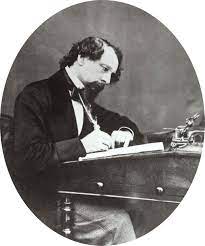
Beside the convent, in a little outhouse with a grated iron door which you may unbolt for yourself, are the bodies of people found in the snow who have never been claimed and are withering away – not laid down, or stretched out, but standing up, in corners and against walls; some erect and horribly human, with distinct expression on the faces; some sunk down on their knees; some dropping over one on side; some tumbled down altogether, and presenting a heap of skulls and fibrous dust.
One set of bodies in particular fascinated both Dickens, who included her in his novel Little Dorrit, and Murray, who includes a description in his travel guide. She is a mother who Dickens describes as “storm-belated many winters ago, still standing in the corner with er baby at her breast.” Dickens pities the mother and gives her voice: “Surrounded by so many and such companions upon whom I never looked, and shall never look, I and my child will dwell together inseparable, on the Great Saint Bernard, outlasting generations who will come to see us, and will never know our name, or one word of our story but the end.” Dickens did not care to create a backstory for the poor, frozen woman and her child. Neither shall I. But his words continue to keep her alive in the hearts of readers some two hundred years after her death.





